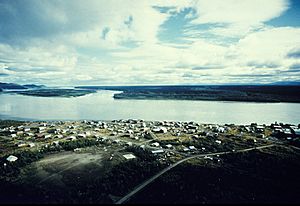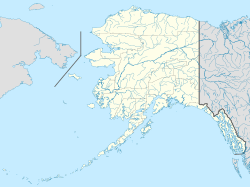Kaltag, Alaska facts for kids
Quick facts for kids
Kaltag
Ggaał Doh
|
|
|---|---|
 |
|
| Country | United States |
| State | Alaska |
| Census Area | Yukon-Koyukuk |
| Incorporated | June 6, 1969 |
| Area | |
| • Total | 27.55 sq mi (71.37 km2) |
| • Land | 21.64 sq mi (56.05 km2) |
| • Water | 5.92 sq mi (15.32 km2) |
| Elevation | 98 ft (30 m) |
| Population
(2020)
|
|
| • Total | 158 |
| • Density | 7.30/sq mi (2.82/km2) |
| Time zone | UTC−9 (Alaska (AKST)) |
| • Summer (DST) | UTC−8 (AKDT) |
| ZIP code |
99748
|
| Area code | 907 |
| FIPS code | 02-37430 |
| GNIS feature ID | 1404379, 2419405 |
Kaltag (say KAL-tag) is a small city and village in Yukon-Koyukuk Census Area, Alaska, United States. Its name in the Koyukon is Ggaał Doh. In 2020, about 158 people lived there. Kaltag is located on the west side of the Yukon River.
Contents
History of Kaltag
Kaltag was once a special area for the Athabascan people of Koyukon. They used it as a cemetery for people from nearby villages. The village is also on an old portage trail. This trail was a path over land that led west through mountains to Unalakleet.
Early Life and Changes
The Athabascans often moved around the area. They followed wild animals for hunting. There were 12 summer fishing camps along the Yukon River. These camps were between the Koyukuk River and the Nowitna River.
The name Kaltag came from the Russians. They named it after a Koyukon man called Kaltaga.
In 1839, a serious sickness called smallpox spread. It caused many people in the area to die.
Gold Rush and New Settlements
After the United States bought Alaska, a telegraph line was built. It ran along the north side of the Yukon River. Around 1880, a trading post opened. This was just before the gold rush of 1884–85.
Steamboats traveled on the Yukon River. They brought supplies to gold seekers. In 1900, the busiest year, 46 boats were on the river. Another sickness, measles, and a lack of food hit in 1900. This caused the population to drop by one-third. The village of Kaltag was officially started after this time. Survivors from three nearby villages moved there.
There was a smaller gold rush in the 1880s. By 1906, many gold seekers left for Fairbanks or Nome. However, lead mines started working in Galena in 1919. Kaltag was downriver from these mines. It grew because it was an important stop for moving goods for the mines. But as mining slowed down in the 1940s, Kaltag's population also went down.
Modern Kaltag
The old cemetery near the river fell into the water around 1937. In the 1960s, an airport and a health clinic were built.
Kaltag holds a special event called the Stick Dance every two years. It is a week-long memorial Potlatch. People from many nearby villages come to visit. Families of those who have recently passed away host this event. They do it to thank everyone who helped them during their time of sadness.
Most of the money earned in Kaltag comes from hunting and fishing. People hunt for salmon, whitefish, moose, and bear. They also gather waterfowl and berries. This way of life helps the community survive.
Geography and Climate
Kaltag is located at 64°19′31″N 158°43′37″W / 64.32528°N 158.72694°W. It sits on the west bank of the Yukon River. It is about 120 kilometers (75 miles) west of Galena. The total area of Kaltag is about 71.37 square kilometers (27.55 square miles). Most of this area is land, with some water.
Weather in Kaltag
The weather in Kaltag is a mix between the coast and the inland areas.
| Climate data for Kaltag, Alaska (1991–2020 normals, extremes 1944–present) | |||||||||||||
|---|---|---|---|---|---|---|---|---|---|---|---|---|---|
| Month | Jan | Feb | Mar | Apr | May | Jun | Jul | Aug | Sep | Oct | Nov | Dec | Year |
| Record high °F (°C) | 58 (14) |
56 (13) |
56 (13) |
61 (16) |
85 (29) |
88 (31) |
95 (35) |
85 (29) |
89 (32) |
69 (21) |
53 (12) |
54 (12) |
95 (35) |
| Mean maximum °F (°C) | 32.0 (0.0) |
36.8 (2.7) |
38.0 (3.3) |
51.7 (10.9) |
74.4 (23.6) |
80.5 (26.9) |
83.0 (28.3) |
75.4 (24.1) |
65.9 (18.8) |
49.9 (9.9) |
32.7 (0.4) |
30.1 (−1.1) |
85.7 (29.8) |
| Mean daily maximum °F (°C) | 4.3 (−15.4) |
14.1 (−9.9) |
21.2 (−6.0) |
38.3 (3.5) |
56.3 (13.5) |
69.3 (20.7) |
69.4 (20.8) |
63.5 (17.5) |
53.2 (11.8) |
34.9 (1.6) |
17.2 (−8.2) |
7.8 (−13.4) |
37.5 (3.0) |
| Daily mean °F (°C) | −4.0 (−20.0) |
4.1 (−15.5) |
9.7 (−12.4) |
27.6 (−2.4) |
45.1 (7.3) |
57.4 (14.1) |
59.3 (15.2) |
54.3 (12.4) |
44.5 (6.9) |
27.8 (−2.3) |
9.4 (−12.6) |
0.1 (−17.7) |
27.9 (−2.3) |
| Mean daily minimum °F (°C) | −12.3 (−24.6) |
−6.0 (−21.1) |
−1.9 (−18.8) |
16.9 (−8.4) |
33.9 (1.1) |
45.5 (7.5) |
49.3 (9.6) |
45.0 (7.2) |
35.7 (2.1) |
20.7 (−6.3) |
1.6 (−16.9) |
−7.7 (−22.1) |
18.4 (−7.6) |
| Mean minimum °F (°C) | −45.7 (−43.2) |
−36.0 (−37.8) |
−27.7 (−33.2) |
−10.0 (−23.3) |
18.1 (−7.7) |
32.6 (0.3) |
38.6 (3.7) |
31.0 (−0.6) |
20.7 (−6.3) |
−1.1 (−18.4) |
−25.9 (−32.2) |
−38.1 (−38.9) |
−47.4 (−44.1) |
| Record low °F (°C) | −60 (−51) |
−57 (−49) |
−46 (−43) |
−30 (−34) |
−11 (−24) |
23 (−5) |
29 (−2) |
26 (−3) |
8 (−13) |
−17 (−27) |
−43 (−42) |
−50 (−46) |
−60 (−51) |
| Average precipitation inches (mm) | 1.02 (26) |
1.29 (33) |
1.45 (37) |
1.39 (35) |
1.02 (26) |
1.65 (42) |
2.24 (57) |
3.38 (86) |
3.17 (81) |
2.78 (71) |
1.43 (36) |
0.72 (18) |
21.54 (547) |
| Average precipitation days (≥ 0.01 in) | 6.7 | 10.1 | 8.7 | 7.5 | 9.1 | 11.7 | 14.1 | 18.0 | 14.6 | 11.0 | 7.5 | 6.5 | 125.5 |
| Source: NOAA | |||||||||||||
Population of Kaltag
| Historical population | |||
|---|---|---|---|
| Census | Pop. | %± | |
| 1880 | 45 | — | |
| 1910 | 141 | — | |
| 1920 | 89 | −36.9% | |
| 1930 | 137 | 53.9% | |
| 1940 | 140 | 2.2% | |
| 1950 | 121 | −13.6% | |
| 1960 | 165 | 36.4% | |
| 1970 | 206 | 24.8% | |
| 1980 | 247 | 19.9% | |
| 1990 | 240 | −2.8% | |
| 2000 | 230 | −4.2% | |
| 2010 | 190 | −17.4% | |
| 2020 | 158 | −16.8% | |
| U.S. Decennial Census | |||
Kaltag first appeared in the U.S. Census in 1880. At that time, it was listed as a village of the Tinneh people. In 1890, Kaltag's population was counted with Anvik. It was not counted separately again until 1910. Kaltag officially became a city in 1969.
In 2000, there were 230 people living in Kaltag. There were 69 households and 52 families. About 84% of the people were Native American. About 12% were White.
Many households (49.3%) had children under 18 living with them. The average household had about 3.33 people. The average family had about 3.83 people.
The population's age spread shows that 37% were under 18 years old. About 7.8% were 65 years or older. The average age was 25 years. For every 100 females, there were about 132 males.
Education
The Yukon–Koyukuk School District is in charge of the Kaltag School.
See also
 In Spanish: Kaltag (Alaska) para niños
In Spanish: Kaltag (Alaska) para niños


